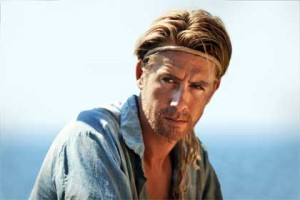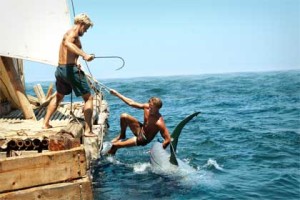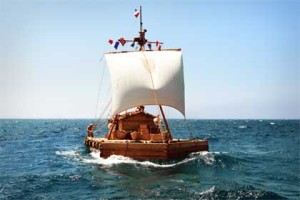Film (2012)
Directed by Joachim Rønning and Espen Sandberg
Screenplay by Petter Skavlan
Script Consultant: Allan Scott
With Pål Sverre Hagen (Thor Heyerdahl), Anders Baasmo Christiansen (Herman Watzinger), Gustaf Skarsgård (Bengt Danielsson), Odd Magnus Williamson (Erik Hesselberg), Tobias Santelmann (Knut Haugland), Jakob Oftebro (Torstein Raaby), Agnes Kittelsen (Liv Heyerdahl)

Photo: Carl Christian Raabe
© 2013 The Weinstein Company. All Rights Reserved.
Thor Heyerdahl, an amateur anthropologist and professional adventurer, set out from Peru in 1947 with a crew of five on a raft made of balsa wood. The goal was to prove a point empirically – that, using a simple craft made of materials available to primitive peoples in South America, it would be possible to navigate to the South Seas. Nobody believed it was possible, but, despite the odds, Heyerdahl was determined to prove his point.
This large film is part character study, part adventure tale, and makes a convincing suspense drama out of the rudiments of a tentative sea journey. Heyerdahl’s resolve is tested at every turn and each of the challenges poses a curious challenge to his capacity to handle the obstacles.
Weak and uncertain crew members squabble with one another. Sharks attack. And the currents do not always behave themselves. There is a final grand obstruction by a coral reef, and, omnipresent is the concern about whether the balsa wood will hold up under constant infusion by seawater and battering by storms.

Tobias Santelmann as Knut
in “Kon Tiki”
Photo: Carl Christian Raabe
© 2013 The Weinstein Company. All Rights Reserved.
Pål Hagen gives a convincing portrait of Heyerdahl, exhibiting an interesting combination of utter determination and quixotic charm and humor. Whether dealing with challenges from his wife or from his raftmates, Hagen does a great job navigating the careful distance between assurance and arrogance, always steering carefully towards the former.
There is one scene in which he does exhibit some anger and tosses something signficant overboard to the extreme consternation of one of his mates. It is a moment of wrath and repudiation but Hagen carries it off with executive confidence.
Agnes Kittelsen provides an interesting combination of schoolmarmishness and sensuality as Liv, Heyerdahl’s wife. She plays a big part early on and one of the curiosities of the film is that it does not follow this theme up as closely as it might; it was something of a disappointment not to get a bit more of her in the follow up.
CGI (computer generated imagery) is used in much the same way it is used in Life of Pi (2012) to reconstruct large and sometimes imposing ocean creatures. They are frighteningly vivid and believable. We have come quite a distance from Steven Spielberg’s early classic Jaws (1975) in conjuring cinematic sea creatures. No doubt, featherless bipeds are next.

Photo: Carl Christian Raabe
© 2013 The Weinstein Company. All Rights Reserved.
The score of the film is sweeping, omnipresent and a bit too grandiose. The overall effect is a little too much like a Lawrence of Arabia (1962) of the seas, too intentionally epic in scope. A slightly more muted tone would have served the film well and done just as much justice to the themes. Though very good, the film’s tendency to grandiosity and romanticism weathers it a bit.
It is nice to see this Norwegian production gain such traction. It is a little odd to see it done in English, but I gather that there was a Norwegian version shot simultaneously. That seems pretty funny, but such are international market forces. I wonder if they also considered Mandarin.
The matter of belief in oneself, despite fantastic personal and professional odds, is the great backbone of this tale. Like the story of Ernest Shackleton and his expedition to Antarctica, this is a not only a great seafaring tale, but a tale of great vision, determination and leadership.
– BADMan
Leave a Reply